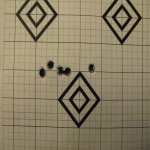Looking at the chart above A,B,C & then D,E,F are the same charge weights but seating depth are different. To me this COL is basically changing the combustion space size, therefore changing the pressure produced, thus effecting the velocity and the rate of acceleration of the bullet down the barrel.
So the way I'm thinking what the seating depth change does is a way of finding the barrel time that is considered a node. This can be done with powder charge. This does not entertain the issue of ES/SD. This is looked after mechanically and weight of the charge as it relates to OCW. So two things need to be addressed at once, OBT and OCW.
From Accurate shooter.com
Pressure happens based on two things. One is the burn of the powder making pressure/gas, the other is the when (or time component) of that pressure and gas. The reason the when matters is that as soon as the pressure starts building the bullet starts moving. When the bullet moves the available space for the expanding gas is enlarged. Since the burn is accelerating and the bullet is also moving enlarging the space, you've got a moving target for where/when Pmax is going to occur. The longer it takes to hit Pmax the bigger the space available to do so, and as a result the more powder you can use and the more energy involved. This is precisely the reason why for a given max pressure, slower burning powders make higher velocities.
Once you are past Pmax the bullet is accelerating ever faster, the volume rapidly expands, and pressure drops as a result of the expanded volume. Simultaneously the powder, once past the Z1 line is in the "fizzle" stage and is mostly burned up already.
When the Z1 line and the P-max lines overlap on the graph, and the OBT is on a node, the loads produced are usually the best the platform will produce.
This is how a friend and myself approach load development.
So the way I'm thinking what the seating depth change does is a way of finding the barrel time that is considered a node. This can be done with powder charge. This does not entertain the issue of ES/SD. This is looked after mechanically and weight of the charge as it relates to OCW. So two things need to be addressed at once, OBT and OCW.
From Accurate shooter.com
Pressure happens based on two things. One is the burn of the powder making pressure/gas, the other is the when (or time component) of that pressure and gas. The reason the when matters is that as soon as the pressure starts building the bullet starts moving. When the bullet moves the available space for the expanding gas is enlarged. Since the burn is accelerating and the bullet is also moving enlarging the space, you've got a moving target for where/when Pmax is going to occur. The longer it takes to hit Pmax the bigger the space available to do so, and as a result the more powder you can use and the more energy involved. This is precisely the reason why for a given max pressure, slower burning powders make higher velocities.
Once you are past Pmax the bullet is accelerating ever faster, the volume rapidly expands, and pressure drops as a result of the expanded volume. Simultaneously the powder, once past the Z1 line is in the "fizzle" stage and is mostly burned up already.
When the Z1 line and the P-max lines overlap on the graph, and the OBT is on a node, the loads produced are usually the best the platform will produce.
This is how a friend and myself approach load development.








































































